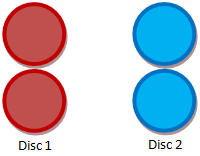 Brad has made two discs for a game.
Brad has made two discs for a game.
These discs should have numbers on each side but he's not sure what numbers to use.
When Brad flips the discs and adds the numbers that he can see, he wants to get only sums of 8, 10, 11 or 13.
What numbers should Brad use?
Solution:
First let's assume that we are only allowed to use natural numbers on the discs (1, 2, 3,...). We need to be able to get a sum of 8, so we know that we need two numbers (one on each disc) that add to 8. If we ignore the fact that we could swap the discs around there are 4 possible pairs (1 and 7, 2 and 6, 3 and 5, 4 and 4).
A little trial and error for each of those options should allow you to find these pairs of numbers that work:
1 and 4 on one disc and 7 and 9 on the other.
1 and 3 on one disc and 7 and 10 on the other.
2 and 5 on one disc and 6 and 8 on the other.
2 and 4 on one disc and 6 and 9 on the other.
3 and 6 on one disc and 5 and 7 on the other.
3 and 5 on one disc and 5 and 8 on the other.
4 and 7 on one disc and 4 and 6 on the other.
Extension:
How many solutions are there if you are allowed to use negative numbers as well? What if you can use fractions?